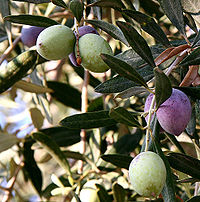
Photo from wikipedia
Olive leaves, which are the most abundant byproducts of the olive industry, offer multiple health benefits. The investigation of the phytochemical profiles and relevant biological activities is an essential step… Click to show full abstract
Olive leaves, which are the most abundant byproducts of the olive industry, offer multiple health benefits. The investigation of the phytochemical profiles and relevant biological activities is an essential step toward transforming these low-value byproducts into value-added ones. This study systematically investigated the phytochemical profiles, antioxidant capacity, and inhibition rates of olive leaves from four cultivars on the α-glucosidase, α-amylase, and angiotensin-converting enzyme (ACE). The leaves were prepared using two common drying methods, namely, hot air-drying and freeze-drying. A total of 33 bioactive compounds were identified in the olive leaves, namely, 19 flavonoids, 2 phenylethanoids, 2 coumarins, 2 hydroxycinnamic acids, 2 iridoids, and 6 triterpenic acids. Quantification of the bioactive compounds revealed high amounts of polyphenols, especially flavonoids [2,027–8,055 mg/kg dry weight (DW)], iridoids (566–22,096 mg/kg DW), and triterpenic acids (13,824–19,056 mg/kg DW) in the olive leaves. The hot air-dried leaves showed significantly (P < 0.05) higher iridoid (oleuropein and secoxyloganin) content than the fresh leaves, while freeze-drying resulted in significantly (P < 0.05) higher flavonoid aglycone and hydroxytyrosol content. Additionally, freeze-drying led to samples with the highest radical scavenging, α-amylase, α-glucosidase, and ACE inhibition abilities. The flavonoid (e.g., quercetin, luteolin, eriodictyol, kaempferol-7-O-glucoside, and luteolin-7-O-glucoside), hydroxytyrosol, and oleanolic acid contents in the olive leaves were positively correlated (P < 0.05) with their bioactive potentials.
Journal Title: Frontiers in Nutrition
Year Published: 2022
Link to full text (if available)
Share on Social Media: Sign Up to like & get
recommendations!